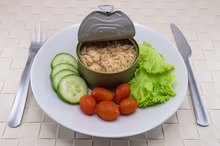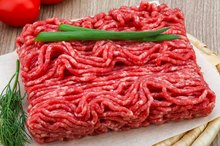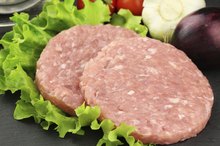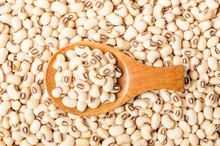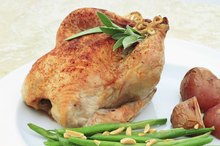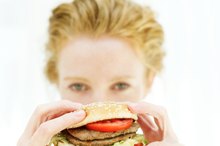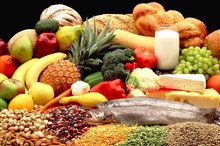What does fact checked mean?
At Healthfully, we strive to deliver objective content that is accurate and up-to-date. Our team periodically reviews articles in order to ensure content quality. The sources cited below consist of evidence from peer-reviewed journals, prominent medical organizations, academic associations, and government data.
The information contained on this site is for informational purposes only, and should not be used as a substitute for the advice of a professional health care provider. Please check with the appropriate physician regarding health questions and concerns. Although we strive to deliver accurate and up-to-date information, no guarantee to that effect is made.
USDA Serving Size Requirements for Meat
Foods in the meat and beans group in the U.S. Department of Agriculture’s healthy eating pyramid provide protein, iron, B vitamins, vitamin E, zinc, magnesium and essential fatty acids 1. However, you don’t need large servings of these foods to meet your daily requirements for protein or other essential nutrients. Most Americans get enough protein in their daily diet, the Centers for Disease Control and Prevention, or CDC, notes 2. Some meats are high in calories, fat and cholesterol, which can promote obesity and heart disease. To enjoy the nutritional benefits of beef, pork, poultry or fish without compromising your health, include no more than the recommended servings in your daily diet.
Meat Requirements
Your requirements from the meat and beans group vary according to your age, gender, activity level and health status. According to the U.S. Department of Agriculture, or USDA, most Americans get enough meat in their diet, but they should eat leaner selections from this group 1. Men ages 19 to 30 should eat 6.5 oz. equivalents from the meat and beans group each day, according to the USDA. Men ages 31 to 50 should eat 6 oz. equivalents from this group daily, and men ages 51 and older should eat 5.5 oz. Women ages 19 to 30 should eat 5.5 oz. equivalents, and women ages 31 and older should eat 5 oz. equivalents daily, the USDA states. A high activity level or certain health conditions may increase your protein needs.
- Your requirements from the meat and beans group vary according to your age, gender, activity level and health status.
- Men ages 19 to 30 should eat 6.5 oz.
Meat Serving Sizes
How to Make Tuna When on a Diet
Learn More
A small round steak represents 3.5 to 4 oz. equivalents, and a small hamburger represents up to 3 oz. equivalents. When preparing beef or pork, the CDC recommends that you buy lean cuts and trim away any visible fat before cooking. Lean beef cuts include top loin or sirloin, round steaks and roasts, chuck roasts and extra-lean ground beef. Lean pork cuts include loin cuts and ham.
- A small round steak represents 3.5 to 4 oz.
- Lean beef cuts include top loin or sirloin, round steaks and roasts, chuck roasts and extra-lean ground beef.
Poultry Serving Sizes
One ounce of cooked chicken or turkey or one slice of turkey that you would serve on a sandwich equals 1 oz. equivalent. A small chicken breast contains 3 oz. equivalents of meat, and one half of a Cornish game hen contains 4 oz. equivalents of meat. The CDC advises that you remove skin from poultry before serving to reduce fat. Lean selections of poultry include boneless, skinless chicken and turkey cuts, the USDA notes.
- One ounce of cooked chicken or turkey or one slice of turkey that you would serve on a sandwich equals 1 oz.
Fish Serving Sizes
Lean Meat and Fatty Meat
Learn More
An ounce of cooked fish or shellfish equals 1 oz. equivalent, according to the USDA. One can of tuna equals 3 to 4 oz. equivalents. One salmon steak equals 4 to 6 oz. equivalents, and one small trout equals 3 oz. equivalents, the USDA notes. The USDA advises that you increase your intake of fish, especially fatty fish such as salmon, herring and trout.
- An ounce of cooked fish or shellfish equals 1 oz.
- equivalents, and one small trout equals 3 oz.
Meat Alternatives
As alternatives to beef, pork, fish or poultry, the USDA includes dried beans, eggs, nuts and seeds in this food group.include:
- As alternatives to beef
- pork
- fish or poultry
- the USDA includes dried beans
- eggs
- nuts
- seeds in this food group
One egg, one-half ounce of nuts or seeds, one tbsp. of nut butter, one-fourth cup of tofu and one-half cup of dried beans or peas represent one ounce equivalents. All of these foods provide protein, fats and essential vitamins and minerals. Beans, nuts and seeds are also rich in fiber. To benefit from the nutrients in all of the foods from the meat and beans group, vary your choices of protein. Because nuts and seeds are high in fat, you should eat these foods in place of meat at any given meal, not in addition to meat, the USDA advises.
- As alternatives to beef, pork, fish or poultry, the USDA includes dried beans, eggs, nuts and seeds in this food group.include: * As alternatives to beef
* pork
* fish or poultry
* the USDA includes dried beans
* eggs
* nuts
* seeds in this food group One egg, one-half ounce of nuts or seeds, one tbsp. - Because nuts and seeds are high in fat, you should eat these foods in place of meat at any given meal, not in addition to meat, the USDA advises.
Related Articles
References
Writer Bio
Anne Tourney specializes in health and nutrition topics. She is a registered nurse with experience in medical-surgical nursing, behavioral health and geriatrics. Tourney earned a Bachelor of Science in nursing from Regis University.
